28 Mar 2025
BlogOverview
The article underscores the transformative role of life science buildings within the industry by 2025, emphasising their critical significance in fostering innovation, sustainability, and advanced research capabilities. It elaborates on this by detailing key trends such as:
- The integration of AI
- Sustainable practices
- The strategic importance of location
- Collaboration spaces
These elements are essential for enhancing operational efficiency and driving economic growth in the biological sector. By understanding these trends, stakeholders can better navigate the evolving landscape and leverage opportunities for advancement.
Introduction
In the rapidly evolving landscape of life sciences, the critical importance of specialised buildings designed to foster innovation cannot be overstated. These purpose-built facilities act as essential hubs for research and development, accommodating laboratories and collaborative environments that drive groundbreaking advancements.
As the sector confronts escalating demands for efficiency and adaptability, the strategic design of life science buildings emerges as a pivotal factor influencing not only scientific progress but also broader economic growth. Recent statistics underscore the substantial economic benefits linked to health equity and innovation, making the role of these facilities more vital than ever.
This article explores the essential features, sustainability practices, and technological innovations that are shaping modern life science infrastructure, while also examining the strategic importance of location and funding in driving future developments within the industry.
Understanding Life Science Buildings: A Catalyst for Innovation
Biological research structures, commonly known as life science buildings, are purpose-designed spaces that play a crucial role in fostering research and development within the biological sector. These specialised facilities accommodate laboratories, offices, and collaborative environments, serving as essential hubs for innovation. Their strategic design and functionality significantly impact the efficiency and effectiveness of research activities, positioning them as catalysts for groundbreaking advancements in the industry.
The importance of these facilities is underscored by recent statistics indicating that reducing health inequities could unlock an impressive £2.8 trillion in economic growth in the UK. This potential emphasises the vital role that life science buildings serve not only in scientific advancement but also in broader economic growth, as they provide the essential infrastructure to support advanced research capabilities. Recent trends in the biological research real-estate market further illustrate this pattern. In Q4 2024, the UK biological sector experienced a significant positive net absorption of 3.4 million square feet leased, marking a 28% increase from the previous year.
This growth occurred despite a rising vacancy rate of 19.7%, driven by robust construction completions and a surge in venture capital funding. Such momentum suggests a promising future for life science buildings as biological research centres and innovation hubs, reinforcing their role in attaining economic growth.
Industry leaders share this perspective, with a considerable number of professionals expressing optimism about the sector’s expansion. For instance, Todd Konersmann, Deloitte’s Global Life Sciences Sector leader, noted that 68% of respondents anticipate revenue increases, while 57% predict margin expansions in 2025. This optimism is fuelled by the growing need for advanced research capabilities and the essential infrastructure that life science buildings provide.
In summary, life science buildings are not merely structures; they are essential elements of the research and development ecosystem. Their design and operational capabilities directly influence innovation outcomes, making them indispensable for companies aiming to push the boundaries of scientific discovery. With the backing of groups such as JLL’s Life Sciences division, which comprises more than 3,000 experts, the advancement of these centres is poised to continue fostering progress in the biological sector.
Designing for Success: Key Features of Modern Life Science Facilities
Modern life science buildings are meticulously designed with key features that significantly enhance their operational efficiency and adaptability. A primary focus is on flexible lab spaces, which can be easily reconfigured to meet the evolving needs of research teams. This adaptability is essential in life science buildings, enabling organisations to respond swiftly to new scientific challenges and project requirements.
For instance, the Earth Microbiome Project plans to analyse 200,000 samples from microbial communities, underscoring the necessity for versatile lab environments that can accommodate diverse research activities.
Advanced HVAC systems play a vital role in maintaining optimal air quality, which is crucial for sensitive experiments and the health of personnel. These systems are increasingly designed to be energy-efficient, contributing to reduced operational costs while ensuring compliance with stringent safety standards.
Moreover, the incorporation of collaborative spaces fosters teamwork and innovation among researchers, creating an environment conducive to groundbreaking discoveries. The integration of smart technologies, such as IoT devices, allows for real-time monitoring of lab conditions, further enhancing the efficiency and safety of these environments.
Statistics indicate a growing trend towards flexible lab space usage in life science buildings, with many organisations acknowledging the significance of adaptable environments in driving research success. In order to deliver the Vision and cultivate growth in the sector, the UK needs to onshore the manufacture and commercialisation of breakthrough products.
Additionally, it is important to consider the requirements of BSL-4 labs, which necessitate maximum containment for handling dangerous agents like the Ebola virus. This emphasises the essential requirement for contemporary life science buildings to be not only adaptable but also prepared to satisfy the highest safety standards.
Looking forward to 2025, the demand for contemporary biological establishments will continue to evolve, propelled by technological advancements and the growing intricacy of research requirements. Successful designs for life science buildings will prioritise flexibility, advanced HVAC systems, and collaborative environments, ensuring that these facilities remain at the forefront of scientific innovation. Case analysis in biostatistics demonstrates how data-informed insights are becoming essential to the biological fields, further emphasising the need for resources that can adjust to new methodologies and technologies.
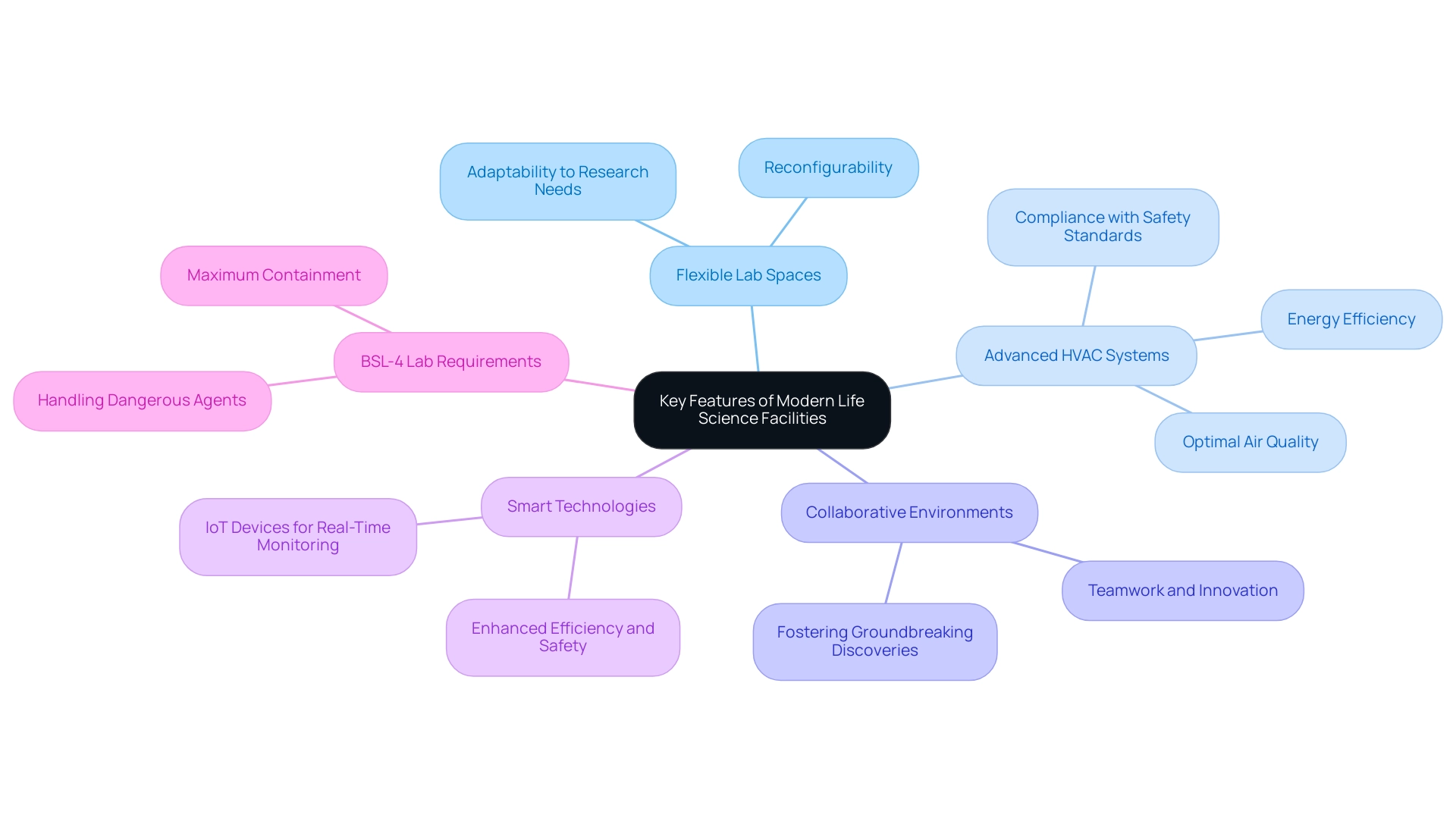
Sustainability in Life Sciences: Building for a Greener Future
Sustainability has emerged as a fundamental principle in the design of biological structures, highlighting the necessity for eco-friendly materials and energy-efficient systems that minimise carbon footprints. Innovative strategies such as rainwater harvesting, solar energy integration, and the utilisation of recycled materials are increasingly adopted to foster environmental stewardship. These sustainable practices not only contribute positively to the planet but also enhance the long-term viability of facilities by lowering operational costs and appealing to environmentally conscious investors.
In 2025, the trend toward sustainability in biological structure design is anticipated to grow stronger, propelled by regulatory pressures and evolving investor expectations. A significant 83% of non-UK respondents in a recent survey indicated that they foresee substantial impacts from the European Union’s Corporate Sustainability Reporting Directive, underscoring a shift toward integrating sustainability into core business strategies. This aligns with the growing recognition that incorporating Environmental, Social, and Governance (ESG) standards into corporate strategies enhances investor confidence and stakeholder involvement within the biotechnology sector.
Edmond Shipway, exemplifies the scale at which sustainability efforts are being implemented in the industry, particularly regarding life science buildings. Our management methodologies prioritise sustainable practices, ensuring that eco-friendly materials and energy-efficient systems are integrated from the outset. Furthermore, a conceptual model has been developed to enhance project management teams’ readiness in implementing sustainable building processes, indicating an evolution in project management practices to support sustainability in construction.
Moreover, case studies reveal the tangible benefits of eco-friendly materials in biological construction. Facilities that prioritise sustainable practices are not only meeting regulatory requirements but are also positioning themselves as leaders in innovation. As the industry continues to progress, the incorporation of sustainable construction methods will be essential in shaping the future of life science buildings, ensuring they are prepared to address the challenges ahead.
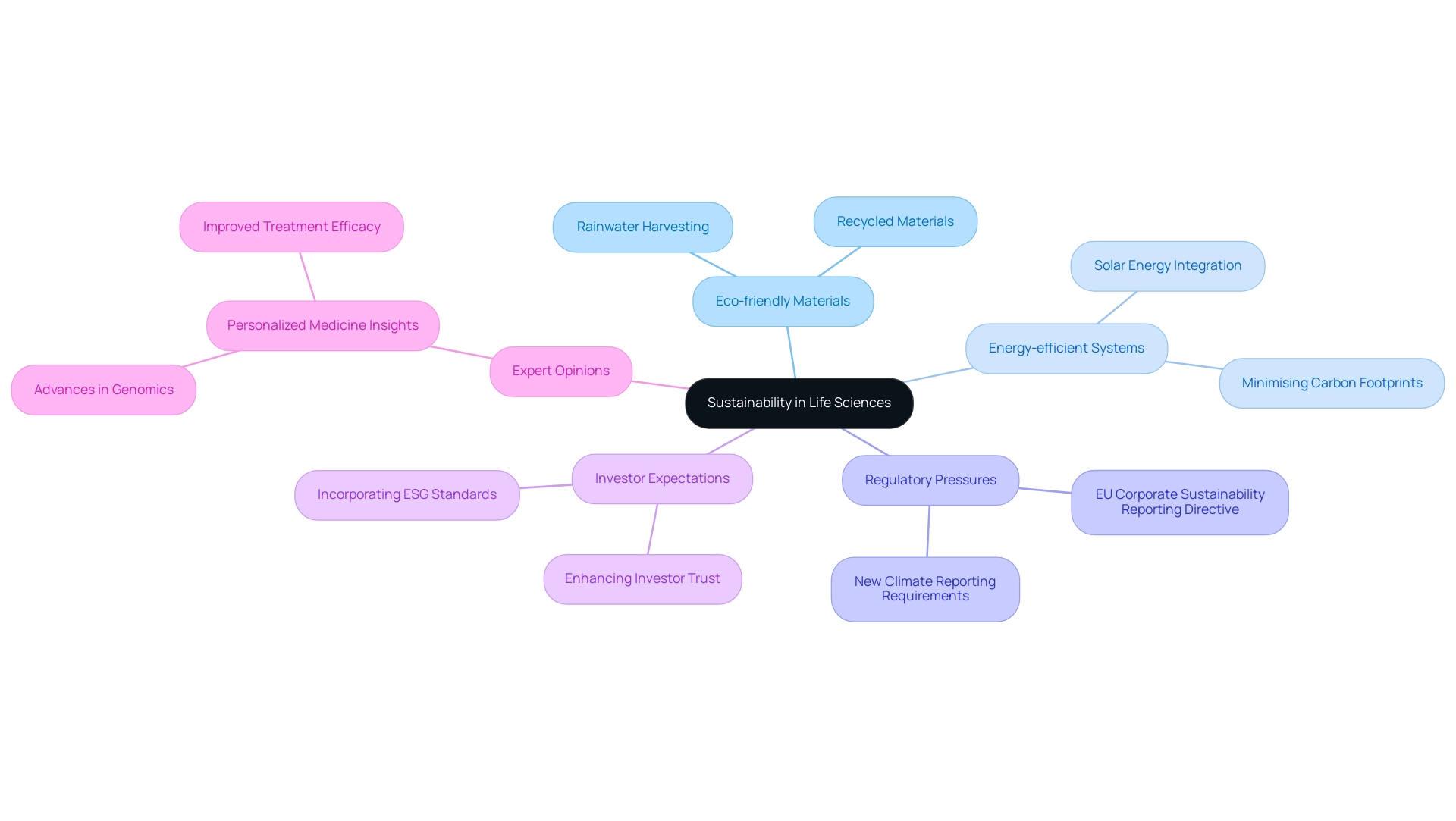
Technological Innovations: Enhancing Life Science Infrastructure
Technological advancements are revolutionising life science buildings, significantly enhancing research capabilities and operational efficiency. At the forefront of this transformation is the integration of advanced laboratory equipment, automation systems, and sophisticated data analytics tools. For instance, AI-driven platforms are increasingly utilised to streamline data management, enabling researchers to make informed decisions more rapidly and accurately.
This paradigm shift not only accelerates research processes but also elevates the overall quality of outcomes. Moreover, the implementation of smart building technologies in life science facilities allows for real-time monitoring of environmental conditions, which is crucial for maintaining optimal performance in laboratories. These innovations contribute to substantial cost savings and improved project timelines, effectively addressing common challenges faced in the sector.
Looking to 2025, the landscape of biological research infrastructure is anticipated to be further shaped by these advancements. Statistics reveal that fossil CO2 emissions have surged to 1.4 percent above 2019 levels, underscoring the urgent necessity for sustainable practices in research environments. In response, many organisations are adopting AI and automation not only to enhance research efficiency but also to align with sustainability goals.
Industry leaders underscore the significance of these technological advancements. As one expert remarked, “We are full of expectations for personalised medicine. With advances in genomics and biomarkers, we can provide patients with more precise treatment options. This not only improves efficacy but also significantly reduces side effects, allowing patients to have a better treatment experience.”
Recent case studies illuminate the impact of these innovations. The latest report on biological studies, for example, includes new analyses of regional growth rates and enhanced data on business sizes, reflecting the sector’s evolution. These enhancements furnish stakeholders with a more detailed and accurate representation of the industry, aiding in strategic decision-making.
Additionally, regular assessments ensure the relevance and quality of the BaHTSS publication, emphasising the importance of quality assurance in the context of technological innovations. As we advance, the incorporation of AI and automation in research facilities will continue to play a crucial role in shaping the future of the sector, enhancing efficiency, and fostering innovation. However, it is essential to acknowledge the challenges faced in the venture capital landscape, which experienced a significant drop in investments in 2022 and 2023, reminiscent of the financial crisis of 2009. This context is vital for comprehending the financial landscape influencing biological infrastructure investments.
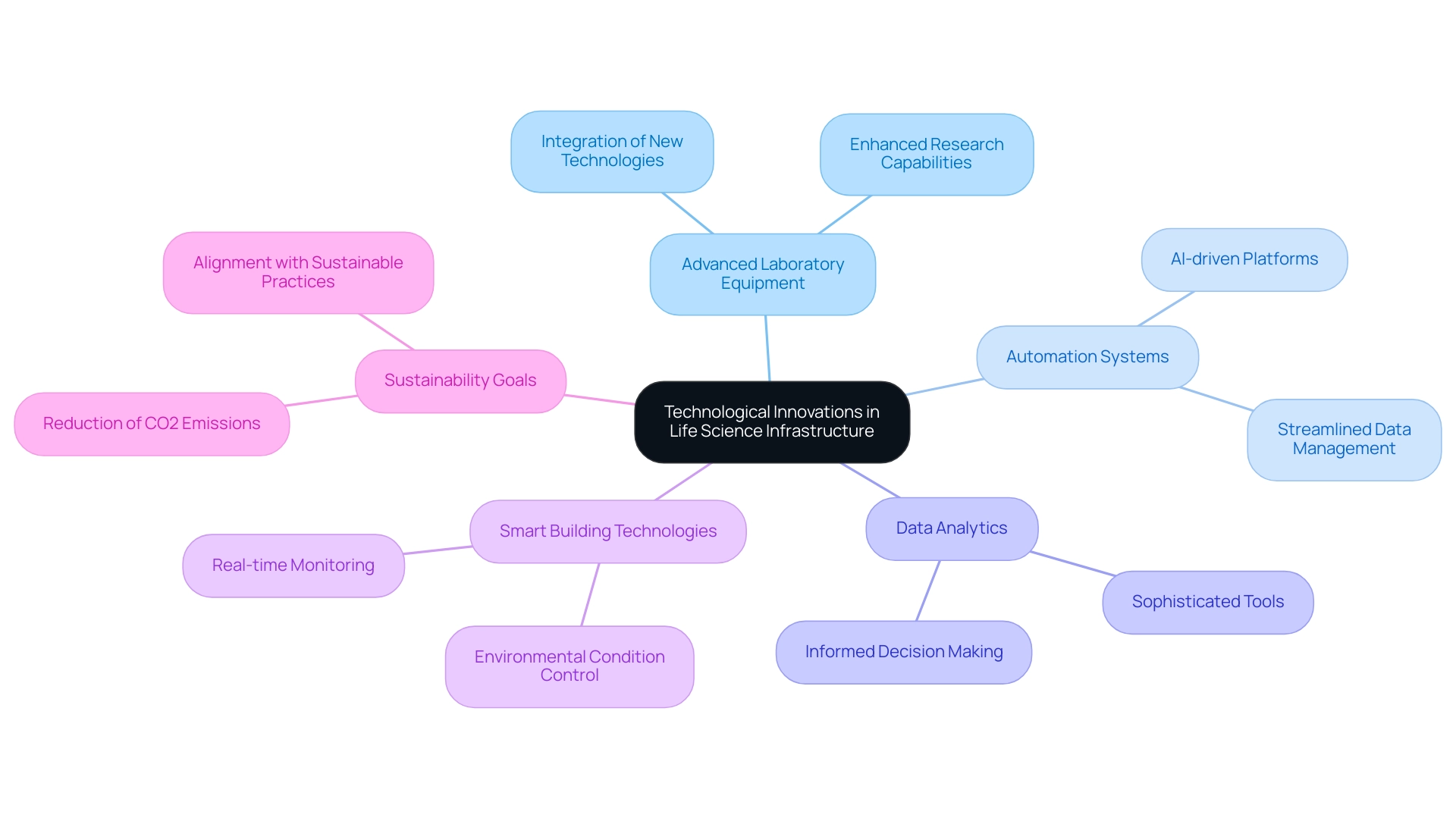
Collaboration Spaces: Fostering Innovation in Life Sciences
Collaboration areas are essential components of research facilities, meticulously designed to foster interaction and teamwork among scholars. These spaces typically include open-plan offices, meeting rooms, and communal lounges, all aimed at encouraging informal discussions and brainstorming sessions. By cultivating environments that prioritise collaboration, organisations can significantly enhance creativity and expedite the innovation process.
The significance of these cooperative environments is underscored by the fact that successful biological initiatives often hinge on the synergy cultivated within these spaces. Research indicates that when scientists operate in collaborative settings, they are more likely to achieve breakthroughs that would be improbable in isolated environments. This is particularly relevant in biological studies, where interdisciplinary approaches are crucial.
Expert opinions bolster this perspective; for instance, a Workspace Futures Researcher, asserts that scientists are increasingly required to perform at higher levels, often in environments that have not evolved to meet their needs. He states, “Scientists are asked to do more, often in environments that haven’t kept pace with their demands. They need spaces that solve practical issues but also inspire them to drive innovation forward.” This viewpoint emphasises the necessity of designing collaboration areas that are not only functional but also conducive to creative thinking.
Statistics reveal that the integration of collaboration areas in biological facilities can yield enhanced outcomes. Facilities that prioritise these areas frequently report higher levels of satisfaction among researchers, correlating with increased productivity and innovation.
Client testimonials illustrate Edmond Shipway’s commitment to excellence in construction consultancy and management. With clients praising the company for completing projects on time and within budget, stating, “The quality of the construction is first class and the handover process has been excellent.”
Moreover, the long-term success of Edmond Shipway is reflected in their impressive 85% repeat business rate, showcasing the satisfaction and trust of their clients. Case studies illustrate the successful designs of shared spaces in research facilities, demonstrating how thoughtful architecture can promote collaboration and enhance the overall research experience. Edmond Shipway’s innovative practices, as evidenced by their approach to project management and sustainability, can significantly improve the design and effectiveness of collaboration spaces.
By investing in these collaborative environments, organisations position themselves to harness the full potential of their teams, ultimately driving advancements in the health sector. Additionally, with Medtech DNA leaders lagging behind their pharma counterparts in scaling DNA, the importance of innovation in collaboration spaces becomes even more critical for maintaining a competitive edge in the industry.
Strategic Locations: The Importance of Accessibility in Life Science Development
The success of biological research facilities is significantly influenced by their location. Proximity to research institutions, universities, and healthcare centres fosters collaboration and attracts elite talent, both of which are essential for innovation in the sector. Furthermore, accessibility to robust transportation networks facilitates partnerships and entices investors, making location a critical factor in strategic planning.
Moreover, the choice of location profoundly impacts the overall cost of development. Sites in high-demand areas often command premium prices, necessitating a careful evaluation of potential sites to ensure that investments align with long-term goals. In 2025, strategic sites for biological research development are expected to become increasingly vital, as the sector adapts to evolving market needs and regulatory environments.
Statistics indicate that reducing health disparities could unlock an impressive £2.8 trillion in economic growth in the U.K., underscoring the importance of accessible biological facilities that cater to diverse populations. Industry leaders assert that accessibility is not merely a regulatory requirement but a fundamental aspect of successful projects in the field.
Furthermore, the anticipated impact of the EU’s Corporate Sustainability Reporting Directive on 2025 strategies highlights the regulatory environment’s influence on location choices for research facilities. As the sector continues to evolve, integrating strategic location planning will be essential for maximising the potential of health-related initiatives. Edmond Shipway’s commitment to innovative practices and continuous improvement enhances results and client relationships, positioning them as a valuable partner in navigating these complexities.
Their expertise in project management, cost efficiency, and sustainability ensures that life science buildings are not only strategically located but also developed to meet the highest standards of regulatory compliance and operational effectiveness.
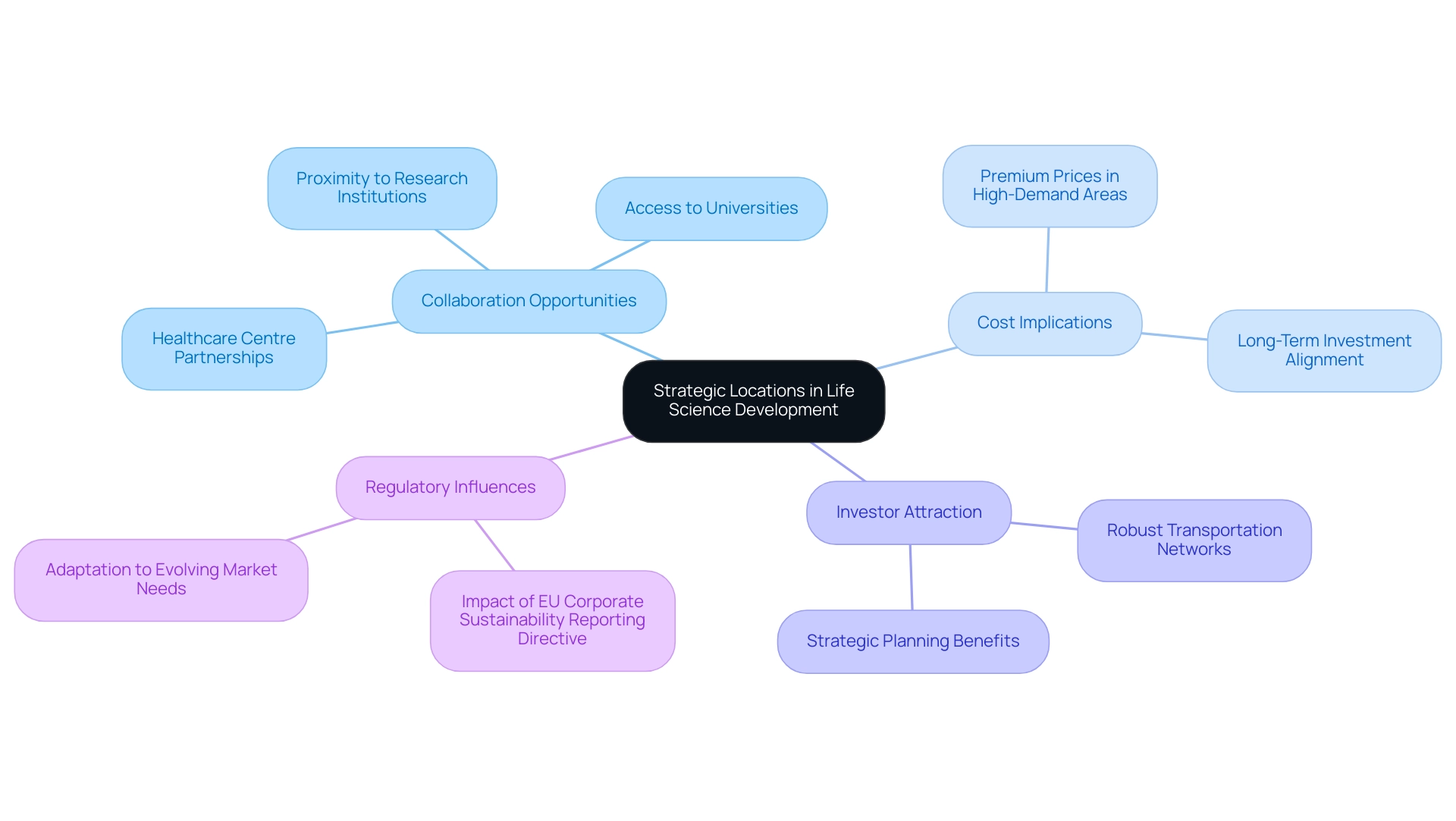
Funding the Future: Financial Trends in Life Science Construction
The landscape of funding for life science building construction is undergoing a significant transformation, driven by a surge in interest from private investors and venture capitalists. As the demand for cutting-edge research facilities escalates, the necessity for robust financial support becomes increasingly apparent. Recent trends reveal a notable shift towards collaborative funding models, where diverse stakeholders—including institutional investors, private equity firms, and government entities, pool resources to finance projects. This approach not only mitigates individual risk but also fosters innovation through shared expertise.
Looking ahead to 2025, the biological sector is anticipated to experience a substantial rise in private funding. Data indicates that Phase III success rates have climbed to 66%, exceeding the 56% average from the last ten years. This increase signals a growing confidence among investors in the potential returns from biological ventures. Moreover, government incentives and grants aimed at bolstering research and development initiatives are becoming increasingly vital, providing substantial backing for new projects.
Expert opinions underscore the importance of understanding these funding trends. As noted by a Research Manager at Deloitte Center for Health Solutions, “The biological sector is set for change in 2025, propelled by digital progress and scientific breakthroughs.” This insight emphasises the crucial role that advancing technologies and cooperative financing models play in shaping the future of construction in the biological sector.
Edmond Shipway, with its comprehensive construction consultancy services, is well-positioned to assist stakeholders in navigating these funding trends. By leveraging its multi-sector expertise, particularly in healthcare, Edmond Shipway can help clients secure funding through collaborative models and capitalise on government support. A recent report examining lab/R&D construction trends across major markets reveals significant variances in fit-out costs, which can inform funding strategies for stakeholders.
Effective partnerships in research funding are essential for managing the intricacies of financing. For instance, a case study titled “Investor Behaviour and Due Diligence in Life Sciences” illustrates how founders are adapting to a more cautious investment climate by maintaining transparent and detailed information to facilitate due diligence. This proactive approach can attract favourable investment terms, even amidst shifting market dynamics.
Overall, stakeholders in the biological sector, especially developers, must remain vigilant regarding the changing financial trends to secure the necessary funding for their initiatives. By leveraging collaborative funding models and capitalising on government support, they can position themselves for success in this rapidly advancing industry.
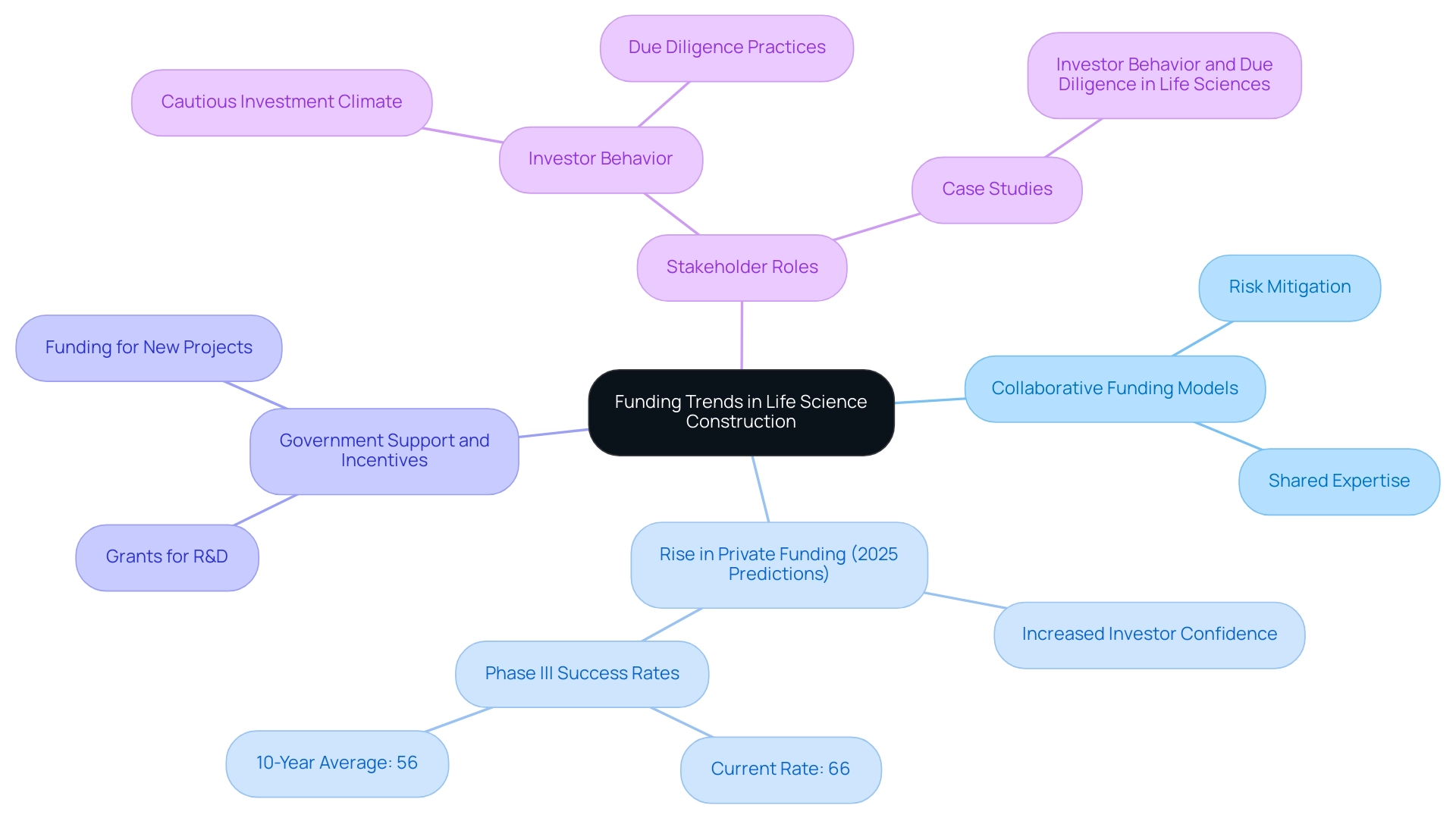
Navigating Regulations: Compliance Challenges in Life Science Development
Adherence to regulations presents a formidable challenge in the construction of life science buildings, which must meet stringent criteria concerning safety, environmental impact, and operational efficiency. The regulatory landscape is complex, requiring meticulous planning and collaboration among various stakeholders. Engaging with regulatory bodies early in an initiative is essential; this proactive approach not only identifies potential obstacles but also streamlines the approval process, ultimately improving timelines.
Successful biological initiatives frequently employ compliance tactics that mitigate risks and ensure conformity with all applicable regulations. For instance, the Association of the British Pharmaceutical Industry (ABPI) has advocated for government actions to bolster the UK’s biological sector, such as the establishment of a Manufacturing Capital Grants Facility and expedited clinical trials legislation. These initiatives highlight the critical importance of a collaborative approach among government, industry, and healthcare providers in addressing compliance challenges.
Statistics indicate that the composite success rate for clinical trials reached 10.8% in 2023, a significant increase attributed to advancements in Phase I, Phase III, and regulatory success. This improvement underscores the vital role that effective regulatory navigation plays in the overall success of biomedical initiatives.
Edmond Shipway’s comprehensive construction consultancy services are tailored to assist developers in effectively navigating these compliance challenges. With an emphasis on management, cost efficiency, and sustainability, Edmond Shipway empowers clients to adopt innovative practices that align with regulatory requirements, ultimately improving outcomes.
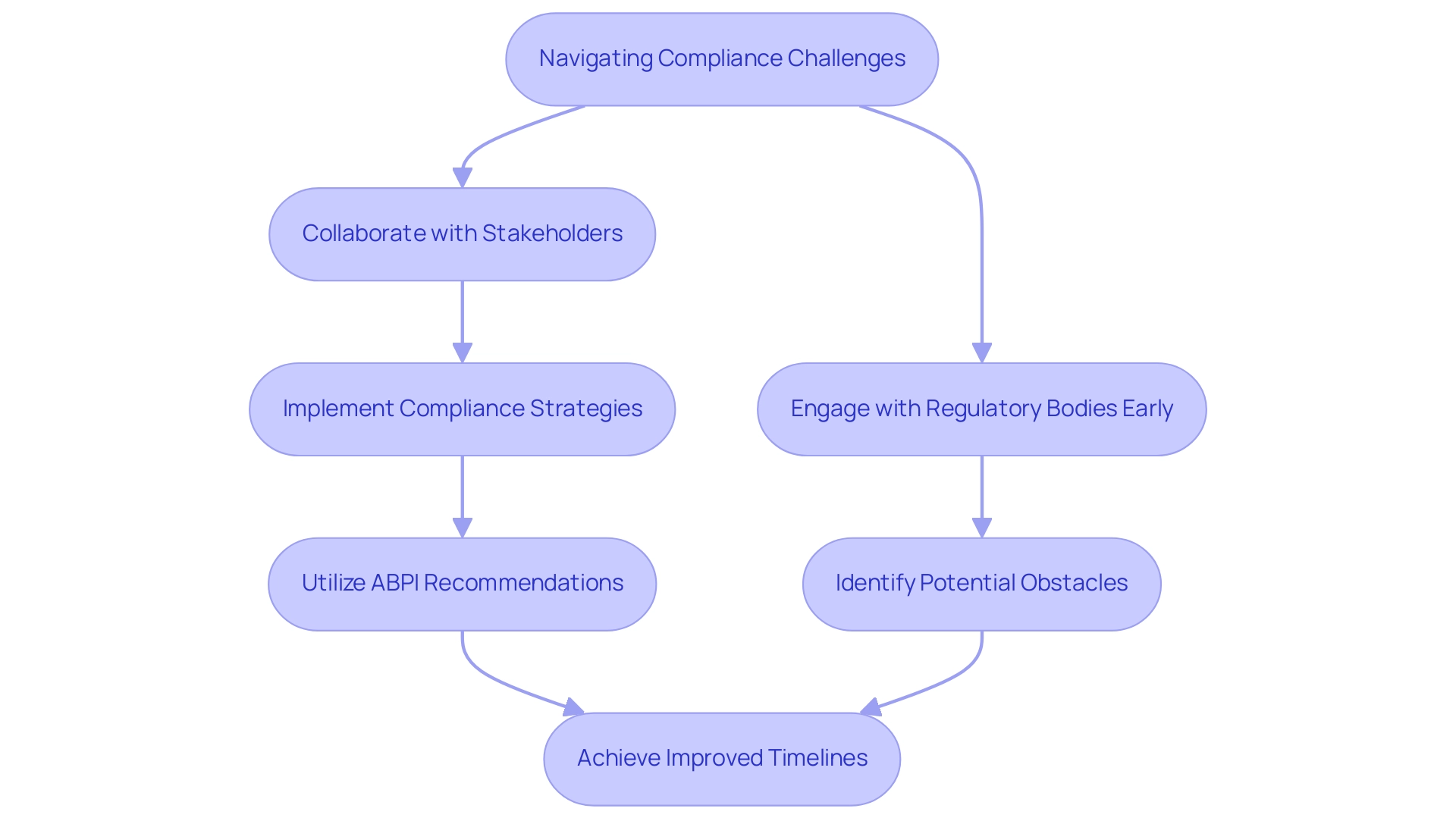
Case Studies: Life Science Buildings Leading the Way in 2025
In 2025, the life science sector is witnessing a remarkable evolution, with several buildings setting new benchmarks for innovation and efficiency. These developments illustrate how strategic design and sustainability can drive transformative change within the industry. A prime example is the One North Quay initiative in London, which has successfully integrated advanced sustainability features. This initiative not only minimises environmental impact but also cultivates collaboration among biotech firms. By emphasising energy efficiency and CO2 reduction, it aligns with the increasing demand for sustainable practices in the sector.
Data indicates that incorporating creative design features significantly contributes to the success of projects in this field. For instance, studies reveal that 58 percent of the workforce faces disruption due to AI integration, highlighting the urgent need for spaces that can adapt to evolving technologies and workflows.
Expert opinions further reinforce the necessity for organisations to prioritise long-term strategic goals when developing biological facilities. Industry leaders emphasise that aligning acquisition targets with growth ambitions is vital for sustainable success. Additionally, collaboration between risk managers and HR leaders is crucial for devising comprehensive strategies that mitigate risks and capitalise on opportunities within the biological sector.
Looking Ahead: Future Trends in Life Science Building Development
The life science buildings sector stands on the cusp of a transformative era, driven by several key trends that are set to redefine development in the coming years. A pivotal force behind this evolution is the integration of artificial intelligence (AI) and machine learning, which are anticipated to significantly bolster the demand for advanced laboratory resources. These technologies not only enhance research capabilities but also streamline operations, fostering environments that are more efficient and responsive to researchers’ needs.
Sustainability remains a crucial focus, as organisations increasingly embrace greener building practices and materials. This shift is underscored by the expectation that 83% of non-UK respondents foresee the EU’s Corporate Sustainability Reporting Directive significantly influencing their strategies in 2025. Such regulations will likely compel developers to prioritise eco-friendly designs that minimise environmental impact while maximising operational efficiency.
Edmond Shipway is strategically positioned to assist clients in navigating these changes through its sustainability consultancy services, emphasising cost efficiency and innovative management methodologies. Moreover, the rise of remote work and digital collaboration tools is reshaping the design of life science buildings. Flexibility and adaptability have become essential features, enabling facilities to accommodate diverse working styles and collaborative efforts among researchers.
Edmond Shipway’s deep-rooted legacy in cost consultancy, combined with a modern approach to management, enhances its capability to support clients in this evolving landscape. The company has effectively managed various projects that illustrate its commitment to sustainability and cost efficiency, ensuring that clients can meet the healthcare sector’s requirements. Keeping pace with these trends is essential for stakeholders seeking to maintain a competitive advantage in the rapidly changing environment of biological research.
The convergence of AI, sustainability, and flexible design will not only augment the functionality of life science buildings but also position them as pivotal assets in advancing research and innovation.
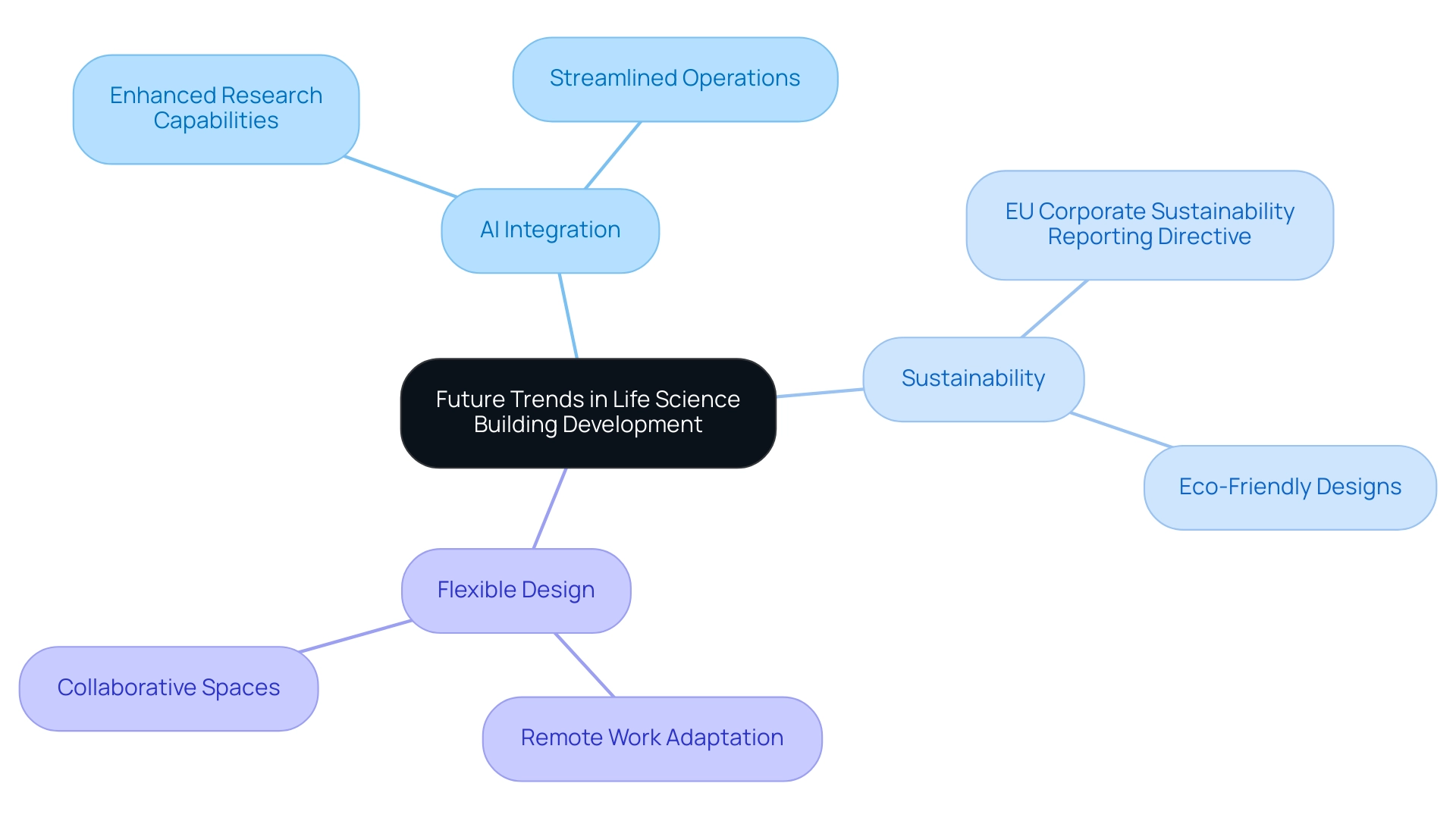
Conclusion
Life science buildings serve as foundational pillars that underpin the continuous evolution of research and innovation within the life sciences sector. This article has explored the critical features of these specialised facilities, underscoring their vital role in fostering collaboration, adaptability, and sustainability. The strategic design and functionality of life science facilities directly influence research outcomes and economic growth, reinforcing their significance in tackling global health challenges.
As the demand for advanced research capabilities escalates, the integration of cutting-edge technologies, such as AI and smart building systems, alongside sustainable practices emerges as a pivotal trend shaping the future of these facilities. The anticipated repercussions of regulatory changes and funding trends further highlight the necessity for strategic planning in developing life science infrastructure.
Successful life science projects necessitate a holistic approach that encompasses collaboration among stakeholders, a commitment to sustainability, and a focus on innovative design. By prioritising these elements, organisations can cultivate environments conducive to groundbreaking discoveries, ultimately advancing healthcare and the economy. The future landscape of life science buildings is poised to be dynamic, driven by the convergence of technology, sustainability, and collaboration, paving the way for a more innovative and equitable world in health sciences.
Share


